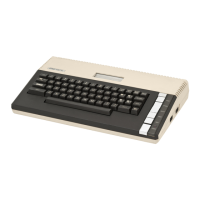





Do you have a question about the Atari 800XL and is the answer not in the manual?
| Manufacturer | Atari |
|---|---|
| Type | Home computer |
| Release year | 1983 |
| CPU | MOS Technology 6502C |
| RAM | 64 KB |
| ROM | 24 KB |
| Operating System | Atari OS |
| CPU Speed | 1.79 MHz (NTSC) / 1.77 MHz (PAL) |
| Graphics | ANTIC and GTIA chips |
| Display resolution | 160×192 to 320×192 pixels |
| Sound | POKEY chip |
| Storage | Cassette tape, floppy disk |
| Ports | Serial, parallel, monitor, joystick ports |
Plug-in cartridges provide quick and easy program loading.
Connects peripheral equipment such as disk drives, program recorders and printers.
For plugging future accessories or peripherals into your computer system.
Provides access to a monitor's superior resolution.
Selects channel 2 or channel 3 for the clearest picture.
To plug in connecting cable from Switch Box.
For connecting touch tablets, key pads, joysticks, and paddle controllers.
Controls the power supply for the computer.
Connects the computer to the television via a switch box.
Detailed steps for connecting the computer to the TV switch box.
Initiates built-in diagnostics for memory, audio-visual, and keyboard.
Checks the computer's ROM and RAM for integrity.
Tests the computer's sound voices and color/graphics capabilities.
Verifies the functionality of the computer's keyboard.
Instructions for properly inserting software cartridges into the computer.
Explains special keys and their functions for editing and graphics.
Stops the computer and returns to the opening screen, usually without data loss.
Usually interrupts computer functions; consult program instructions.
Used to navigate menus or exit programs, varying by software.
Controls features when pressed with other keys, essential for editing/graphics.
Chooses program variations; consult specific software instructions.
Initiates game or program execution; refer to program instructions.
Selects applications within a program; function varies by program.
Provides program-specific assistance and guidance.
Specific combinations of CONTROL with numbers or keys for various functions.
Makes space to insert a program line or text line.
Deletes text or program line at the cursor.
Types upper-case characters without leaving the current mode.
Shifts between upper/lower-case modes; releases CONTROL LOCK.
Enters CONTROL LOCK mode for graphic character creation.
Locks keyboard in upper-case mode for alphabetic characters.
Keys that move the cursor up, left, and right when used with CONTROL.
Returns cursor to left margin; indicates end of line/editing.
Turns reverse video mode on and off; may be called Atari logo key.
Utilizes 29 built-in graphics characters for charts, art, and doodling.
How to display graphics characters using CONTROL and other keys.
Accesses special characters for foreign language typing.
Method to enable international characters via BASIC POKE command.
Overview of ATARI BASIC, a popular programming language.
How to enter, run, and edit BASIC programs using RETURN and RUN.
Understanding and correcting common BASIC programming errors.
Example program demonstrating graphics capabilities.
Example program showcasing sound and animation.
Example program for fun, demonstrating screen effects.
Importance of saving data with recorders or disk drives.
Details the ATARI 1010 for recording data on cassette tapes.
Explains the ATARI 1050 for faster, efficient data storage.
Overview of ATARI printers like 1027, 1025, and 1020 for various printing needs.
Using ATARI MODEM and telephone for online access and information.
Suggestions for maintaining a clean and safe computer work area.
Lists essential books and technical reference materials for Atari users.
Highlights relevant magazines like ATARI Connection and Antic.
Information on joining local Atari User's Groups for support and community.
Troubleshooting steps for when the computer does not turn on.
Diagnosing and fixing issues with distorted TV display.
Explains why the HELP key might not function in certain programs.
Troubleshooting common errors when running ATARI BASIC programs.
Information on potential interference with radio/TV reception.